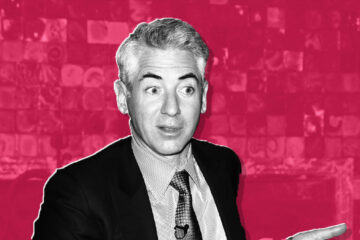Stocks are rallying, but an ominous indicator may soon be flashing warning signs of a market-busting recession.
The 2-year Treasury yield is eclipsing the 10-year Treasury yield.Yield inversions have historically preceded recessions.Stocks can still climb in the year following an inversion.
Stocks don’t climb or fall in a straight line and mean reversions (pullbacks or rallies to support or resistance, respectively) can be jaw-dropping. Still, most reversions are simply examples of the ever-present tug-of-war between profit-seekers and profit-takers in an established trend—nothing more, nothing less.
You can buy pullbacks in an up-trending market or sell rallies in a down-trending market. However, knowing whether to buy or sell is particularly challenging when reversions occur near potential inflection points, such as the beginning or end of a bull or bear market.
In those circumstances, consulting the bond market can help because historically, the bond market is considered the more intelligent in the bond/equity family.
Unfortunately, the bond market doesn’t appear to have a lot of confidence that the Fed can control inflation without damaging the economy. That should make investors nervous because a weak economy can mean a weak stock market.
In Real Money’s “It’s a Tale of Two Markets: Equities Vs. Bonds,” Maleeha Bengali says:
“The overriding theme in bond markets is one of inflation. It does not trust the Fed, as the market senses the Fed is too late to the party, and the move in the front of the curve is falling much faster than the back, a process called flattening, which is usually synonymous with bearish or recessionary markets.”
This market distrust is evident in the yield spread between 10-year Treasuries and 2-year Treasuries. The gap separating the two is a meager 0.03% on March 29, down from 1.56% one year ago (Note: the gap was -0.06% at noon on April 1).
The compression in the 2/10 spread suggests bond participants think shorter-term rates will skyrocket, causing inflation to retreat, and then the Fed will need to switch gears and cut again because of a slowing economy. (The 10-year yield should be more than a 2-year yield because investors demand a greater yield to compensate for opportunity cost and inflation).
Back to Bengali:
“The more the market prices in higher rates in the front, the bond market is pricing in more cuts in the future. This is the rationale used by the equity market to condone further buying. But truth be told, the bond market does not trust the Fed, as it knows fully well, that the Fed is about 500 basis points behind the curve and needs to aggressively tighten. It also knows that the Fed cannot support the markets until inflation comes down to its 2% average.”
A rock and a hard place?
Watching the 2-year/10-year yield spread for an inversion is crucial because it’s been a good harbinger of recession. 2/10 inversions have preceded each recession since 1955, including the six recessions since 1980 (recessions reflect two consecutive quarters of negative GDP growth).
TheStreet
Based on the preceding chart, an inversion wouldn’t bode well.
If a recession is looming (and some argue it’s inevitable), the recent stock market rally could be a painful, late-quarter head fake.
In the short term, stocks can be pushed and pulled in different directions, especially at the end of a quarter when big money advisors and funds make changes that will be reflected in quarterly updates to clients.
As Bengali explains:
The March “quadruple witching” — when stock-index futures contracts, stock options, stock-index futures options, and stock index options expired — caused massive futures hedging and a break higher due to the derivative positioning of the market. One must not forget that month-end and quarter-end flows tend to be big influencing factors, as well. Judging by the performance of equities over bonds, bond selling vs. equity buying window dressing is adding to this trend as well.
Window dressing can unlock animal spirits in shorter-term investors, resulting in fear-of-missing-out buying, and that may be helping the recent rally. However, where the rubber meets the proverbial road will be if the rally continues in April after quarter-end reshuffling.
Also problematic is that there’s increasing evidence global consumers are near a breaking point. For example, in the U.S., inflation at 40-year highs has caused a steep decline in the widely-watched Michigan Consumer Sentiment Survey:
TheStreet
And it’s not only U.S. consumers who are buckling. In the Action Alerts PLUS morning update to members today, the AAP team wrote:
“Germany’s April Gfk Consumer Confidence figure came in at -15.5 which blew through expectations of -11.2 and was well below March’s reading of -8.5. France’s March Consumer Confidence Survey also matched mid-term lows seeing 91.0 which hasn’t been seen since February of 2021 and is spurred by Russia/Ukraine war inflation expectations. We see these data points indicating consumers expect the war in Ukraine to have a continued significant impact on energy prices and in turn, overall consumer spending power. While consumer spending accounts for ~67% of GDP in the U.S., it drives roughly 51% of GDP in Europe.”
This matters because if consumer spending nosedives because of inflation, S&P earnings estimates could be too high.
Back to AAP:
“We’d also note despite all of the factors that have unfolded during the current quarter, consensus expectations for the S&P 500 for the first half of 2022 have inched up compared to where they were in early January, setting the stage for what could be a volatile market as the March quarter earnings season gets underway before too long.”
If multinationals offer a dire outlook in upcoming earnings reports, downward revisions to current forecasts should follow, presenting another headwind to the recent stock market rally. However, we won’t know if earnings estimates will go lower for the S&P 500 until most companies report, so a clearer picture won’t emerge until May.
Should Investors Run for the hills?
A possible 2/10 yield inversion, slowing economic growth, and lower earnings estimates aren’t a recipe for stock market gains, but you should know some other things.
For example, while inversions have happened before every recession since 1955, there was one false signal in the mid-60s (the economy slowed but escaped a recession). Also, it’s not like the 2/10 inversion leads to immediate recession or stock market losses.
For example, it’s taken between 6-months and 24-months for a recession to emerge following a 2/10 inversion. And the average return of the S&P 500 in the 12-months following a 2/10 inversion has been 7.4% since 1978.
This suggests that selling willy-nilly because of an inversion in the 2/10 yield might not be your best move.
A better approach could be waiting and watching the 3-month/10-year spread. It has a solid track record of forecasting recession too, but unlike the 2/10, it’s nowhere near inverting:
TheStreet
However, the typical return following a 3-month/10-year inversion is just 1.4%, so you’ll want to keep tabs on it if it starts flattening or inverts too.
What about QE?
Some wonder if the Fed’s quantitative easing (QE) program has broken the 2/10 year indicator.
The Fed’s bought trillions of dollars worth of bonds with various maturities since QE kicked off in March 2020, and its buying has helped tamp down 10-year rates, contributing to the yield curve flattening. That may not continue, though, because the Fed’s no longer replacing 100% of its maturing assets, and it plans to start selling bonds soon.
Currently, the Fed holds $5.76 trillion in Treasuries, up from about $2.5 trillion in March 2020. Still, only about $1 trillion is in Treasuries with 5- to 10-year maturities, and $1.4 trillion is in Treasuries maturing in 10+ years. That sounds like a lot, but the Treasury market is massive.
If it sells the 10-year Treasuries in its portfolio, it could help steepen the curve by increasing the 10-year yield, but that will only work if its selling isn’t met by an equal or more significant amount of buyers seeking shelter in bonds.
Here’s How Investors Should Play This
If you’re an active investor with a short time horizon, uncertainty means you’ll want to play some defense, including limiting or avoiding leverage.
Use rallies to sell high-valuation stocks that perform best in the early stages of the economic cycle when the Fed is cutting, not hiking, and buy baskets that do better in the late stage, such as commodity-related, healthcare, and utility stocks. A healthy cash position can also allow you to exploit short-term shifts in sentiment.
If you’re a long-term investor, consider increasing your exposure to defensive baskets, so you (at least) match exposure to the S&P 500. Then, revisit the amount you’re contributing to your retirement account. If you can increase the amount you’re investing each month, you’ll wind up with more shares at a lower average cost if the market falls over the next 12-18 months. This may boost your return when the market eventually heads higher because the S&P 500 returns a show-stopping average of 38% in the first year of a bull market (the second year is below 12%).


